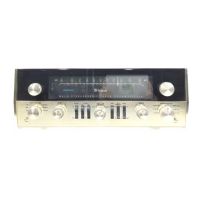FILTERS
Figure 10. LF Rumble Filter Switch.
Low frequency noise below 50 cps is
reduced by pushing the LF rumble filter
switch to the IN position. Low frequency
acoustically coupled feedback is also re-
duced by this switch.
Figure 11. HF Filter Switch.
Surface noise above 5000 cycles is re-
duced when reproducing old, badly worn
recordings by pushing the HF filter switch to
the IN position.
POWER BALANCE
Figure 12. BALANCE Control.
The POWER ON-OFF switch is the center
or small knob of this dual control. The MX 110
is off when the POWER switch is turned to the
POWER OFF or left position (counterclock-
wise).
On the back panel of the MX110 there are
three A.C. OUTLETS. Two of these are black
and the other is red. The power to the black
outlets is controlled by the POWER switch.
The RED outlet is used for power to a turn-
table or a record changer. The turntable or
record changer drive system is protected by
this arrangement. It is necessary to turn off
the turntable or record changer with its own
control switch. The two black outlets and the
red outlet are not fused. Maximum rating for
these outlets is 350 watts total.
The BALANCE control balances the MX110
for unequal program sources. Turning the
control to the left accents the left channel by
reducing the right channel output. Turning
the control to the right accents the right
channel by reducing the left channel output.
LOUD
Figure 13. LOUD Compensation Switch.
When you turn down the volume, the
music will seem to lose much of its bass and
some of its treble. This effect is due to the
sensitivity characteristic of human hearing.
The response of the human ear to bass and
treble pitch decreases more rapidly than
its response to notes centered in the mid-
tonal range. The LOUD control automatically
provides the correct amount of bass and
treble boost required to compensate for this
change in response of the human ear at low-
loudness levels. When the "LOUD" switch is
moved to the IN position, it converts the
volume control to a loudness compensated
control. Use the LOUD IN to listen at low
volume and still hear full-frequency range.
8

